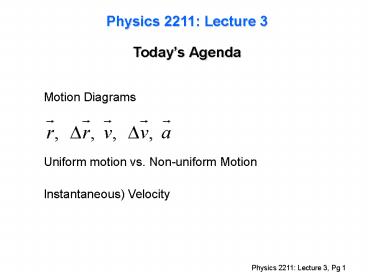Physics 2211: Lecture 21 Notes PowerPoint PPT Presentation
1 / 17
Title: Physics 2211: Lecture 21 Notes
1
Physics 2211 Lecture 3Todays Agenda
Motion Diagrams Uniform motion vs.
Non-uniform Motion Instantaneous) Velocity
2
Trajectory Recap
Origin of Coordinates
3
Mechanics Vocabulary
- Average Acceleration
Rate of Change of Velocity
4
Example 1.4 (Skier)
5
Example 1.7 (Projectile Motion)
6
A
Green arrows are vectors of for a runner circling
a track.
Which red vector best represents the average
acceleration at point A?
7
7
Circular Motion
8
Vocabulary of Mechanics
- Speeding Up vs Slowing Down
- Accelerate vs Decelerate
- Positive acceleration vs Negative
acceleration
9
Kinematic Signs (Tactics Box 2.1)
10
Problem Solving Strategy (Example 1.10)
A rocket is launched vertically with an
acceleration of 30 m/s2. It runs out of
fuel after 30 seconds. What is its
maximum altitude?
11
Dimensions and Units...
- SI (Système International) Units
- mks L meters (m), M kilograms (kg), T
seconds (s) - cgs L centimeters (cm), M grams (gm), T
seconds (s) - British Units
- Inches, feet, miles, pounds, slugs...
- We will use mostly SI units, but you may run
across some problems using British units. You
should know how to convert back forth.
12
Units of Kinematic (Motion) Quantities
13
Converting between different systems of units
Useful Conversion factors 1 inch 2.54 cm 1
m 3.28 ft
14
Converting between different systems of units
Useful Conversion factors 1 inch 2.54 cm 1
m 3.28 ft
15
Dimensional Analysis
- An important tool to check your work. EASY TO
USE! - Example
- You do a problem and find for a distance d
- d vt 2 (velocity x time2)
- Units on left side L
- Units on right side (L / T) x T2 L x T
- Left units and right units dont match, so answer
must be wrong!! - Tip Dont do algebra with numbers.
16
More Tips
- Read !
- Before you start work on a problem, read the
problem statement thoroughly. Make sure you
understand what information is given, what is
asked for, and the meaning of all the terms used
in stating the problem. - Watch your units !
- Always check the units of your answer, and carry
the units along with your numbers during the
calculation. - Understand the limits !
- Many equations we use are special cases of more
general laws. Understanding how they are derived
will help you recognize their limitations (for
example, constant acceleration).
17
Next Lecture
Kinematics Read Chapter 2

